Hello Everyone, In the world of avian splendor, bluebirds stand out as exquisite gems adorned in varying shades of blue. These enchanting creatures captivate bird enthusiasts and nature lovers alike with their vibrant hues and melodious calls. While their name suggests a uniform appearance, the realm of bluebirds is actually a tapestry of distinct species, each possessing its own unique characteristics. Let’s embark on a journey to unravel the diversity within the world of bluebirds and discover the enchanting tales behind their captivating variations.
Types Of BlueBirds
1. Eastern Bluebird (Sialia sialis):
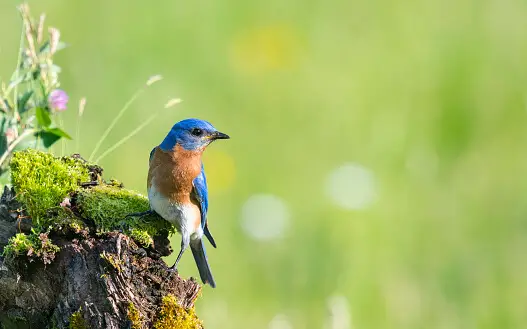
Scientific Name: Sialia sialis
Size: Approximately 6.3 to 8.3 inches (16 to 21 cm) in length, with a wingspan of about 9 to 12 inches (23 to 30 cm).
Features: The Eastern Bluebird, scientifically known as Sialia sialis, is a charming songbird that graces the landscapes of eastern North America with its vivid colors and sweet melodies. This bird is a delight to behold, adorned with stunning blue plumage on its upperparts, contrasting elegantly with its rust-colored breast. Male Eastern Bluebirds exhibit more vibrant and intense shades of blue, especially on their wings and tails, while females boast a softer blue with grayish undertones.
Habitat: Eastern Bluebirds prefer habitats characterized by a mix of open woodlands, meadows, farmlands, and suburban areas. These adaptable birds have managed to thrive in environments modified by human activity. They are commonly spotted perched on wires, posts, or low branches, often scanning the ground for insects and other small prey.
The Eastern Bluebird is not only recognized for its visual appeal but also for its delightful musical abilities. Their song is a series of melodious warbles and trills that adds a joyful touch to the natural orchestra. These songbirds are cavity nesters, which means they seek out sheltered locations like tree hollows, abandoned woodpecker holes, and even man-made nest boxes to raise their young.
2. Mountain Bluebird (Sialia currucoides):
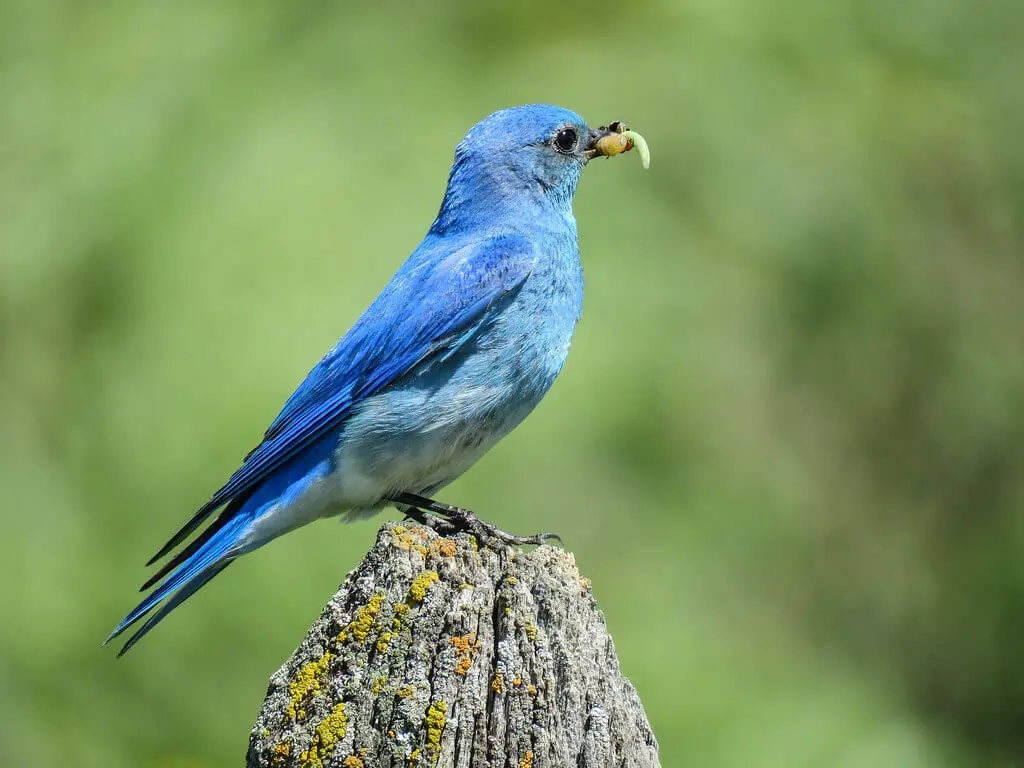
Scientific Name: Sialia currucoides
Size: About 6.3 to 7.9 inches (16 to 20 cm) in length, with a wingspan of around 9.8 to 12.6 inches (25 to 32 cm).
Features: The Mountain Bluebird, scientifically referred to as Sialia currucoides, is a true embodiment of sky-blue beauty. Its upperparts are adorned with a mesmerizing shade of azure blue, evoking the vast heavens themselves. The underparts exhibit a paler blue hue, creating a striking contrast. A distinctive feature of the Mountain Bluebird is its clean and crisp appearance, making it appear as though a piece of the sky has come alive.
Habitat: Mountain Bluebirds are often found in open grasslands, sagebrush plains, and mountainous regions across western North America. Their habitat preferences often intersect with the arid landscapes of the western United States and parts of Canada. They have a penchant for perching on fence posts and utility wires, providing them with vantage points to spot insects and other small prey.
These magnificent birds often nest in natural cavities, such as old woodpecker holes or hollows in trees, but they readily accept nest boxes as well. Their nesting sites are typically situated in slightly more elevated areas, which align with their preference for open spaces. Mountain Bluebirds not only add a splash of color to their surroundings but also contribute their sweet, warbling songs to the chorus of the wild.
In essence, the Eastern Bluebird and the Mountain Bluebird showcase the incredible diversity within the bluebird family. These avian wonders embody the beauty of the skies and bring their unique colors, songs, and habitats to the natural canvas, reminding us of the boundless wonders found in the world of birds.
3. Western Bluebird (Sialia mexicana):
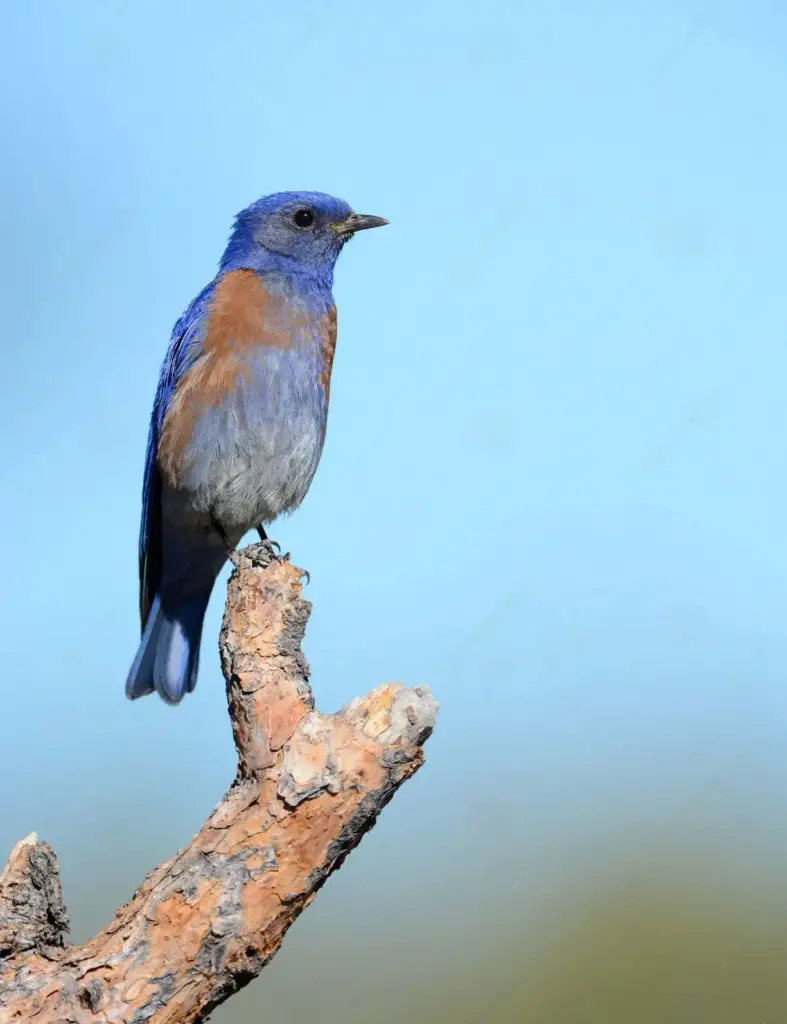
Scientific Name: Sialia mexicana
Size: Approximately 6.3 to 7.9 inches (16 to 20 cm) in length, with a wingspan of about 9.1 to 12.6 inches (23 to 32 cm).
Features: The Western Bluebird, scientifically known as Sialia mexicana, is a symbol of western landscapes adorned with its vibrant blue plumage. This species boasts deep blue upperparts, which contrast elegantly with its orange-brown breast and sides. Male Western Bluebirds typically have more intense blue hues, while females exhibit a softer and slightly grayer shade of blue. Their delicate features and striking colors make them a sought-after sight for bird enthusiasts.
Habitat: Western Bluebirds are inhabitants of open woodlands, grasslands, and meadows, especially in the western regions of North America. Their presence graces areas with sparse vegetation and scattered trees, where they can easily perch and scan for insects, their primary source of food. Like their counterparts, they are cavity nesters, frequently using tree hollows or nest boxes to raise their young.
4. Indigo Bunting (Passerina cyanea):

Scientific Name: Passerina cyanea
Size: Approximately 4.7 to 5.5 inches (12 to 14 cm) in length, with a wingspan of around 7.5 to 9.1 inches (19 to 23 cm).
Features: The Indigo Bunting, scientifically referred to as Passerina cyanea, brings a touch of sapphire to the avian world. While not as overtly blue as other bluebirds, male Indigo Buntings exhibit a vibrant blue plumage during the breeding season, particularly on their head, back, and wings. Females, on the other hand, have more subdued brownish plumage. Their small size and striking colors make them a favorite among birdwatchers.
Habitat: Indigo Buntings are commonly found in grassy habitats, including open woodlands, brushy areas, and cultivated lands across North America. Their vibrant blue is a treat for the eyes, especially when illuminated by sunlight. Their distinctive song, resembling a jingling coin, often reveals their presence even before they come into view.
These unique bluebird species – the Western Bluebird and the Indigo Bunting – showcase the breathtaking array of hues that can be found among avian creatures. Whether adorning the landscapes of the West or adding a splash of brilliance to open grasslands, these bluebirds remind us of the natural world’s ever-present artistry.
5. Lazuli Bunting (Passerina amoena):
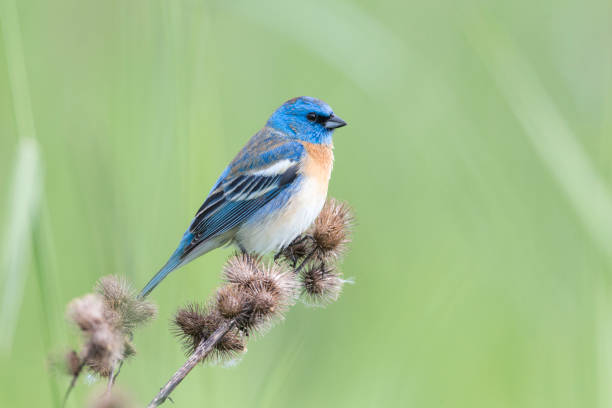
Scientific Name: Passerina amoena
Size: Approximately 4.7 to 5.1 inches (12 to 13 cm) in length, with a wingspan of about 7.1 to 8.7 inches (18 to 22 cm).
Features: The Lazuli Bunting, scientifically known as Passerina amoena, is a testament to nature’s artistic prowess. Dressed in a striking azure blue on their head, back, and wings, these birds embody the beauty of a clear sky. Their underparts exhibit a pale blue, gradually transitioning to white. Males dazzle with their bold blue hues, while females sport a more modest appearance in shades of brown and blue.
Habitat: Lazuli Buntings inhabit a variety of environments, including open woodlands, scrublands, and even gardens, across western North America. Their presence is a visual feast, especially against the backdrop of green foliage. Their distinctive song adds an auditory dimension to their allure, making them a sought-after sighting for bird enthusiasts.
6. Violet-green Swallow (Tachycineta thalassina):
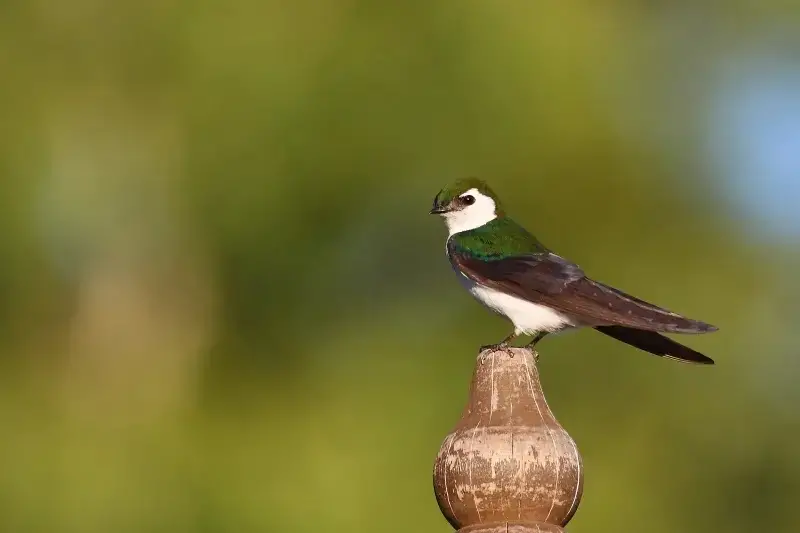
Scientific Name: Tachycineta thalassina
Size: Approximately 4.7 to 5.9 inches (12 to 15 cm) in length, with a wingspan of around 10.2 to 11.0 inches (26 to 28 cm).
Features: The Violet-green Swallow, scientifically referred to as Tachycineta thalassina, is a harmonious blend of iridescent colors. Their upperparts shimmer with violet and green hues, while their underparts showcase white feathers. Their forked tail, a characteristic feature of swallows, adds to their distinctive appearance.
Habitat: Violet-green Swallows frequent a range of habitats, including woodlands, forests, and even urban areas, across western North America. Their acrobatic flight patterns and flashes of violet and green make them an enchanting sight against the sky. They often nest in cavities, including tree hollows and even artificial structures, showcasing their adaptability.
These two unique bluebird species, the Lazuli Bunting and the Violet-green Swallow, illuminate the skies with their dazzling colors and captivating behaviors. As they glide through their habitats, they paint the natural canvas with shades that evoke the serenity of a calm sea or the brilliance of a vivid gemstone.
7. Eastern Blue-tailed Glossy Starling (Lamprotornis chalybaeus):
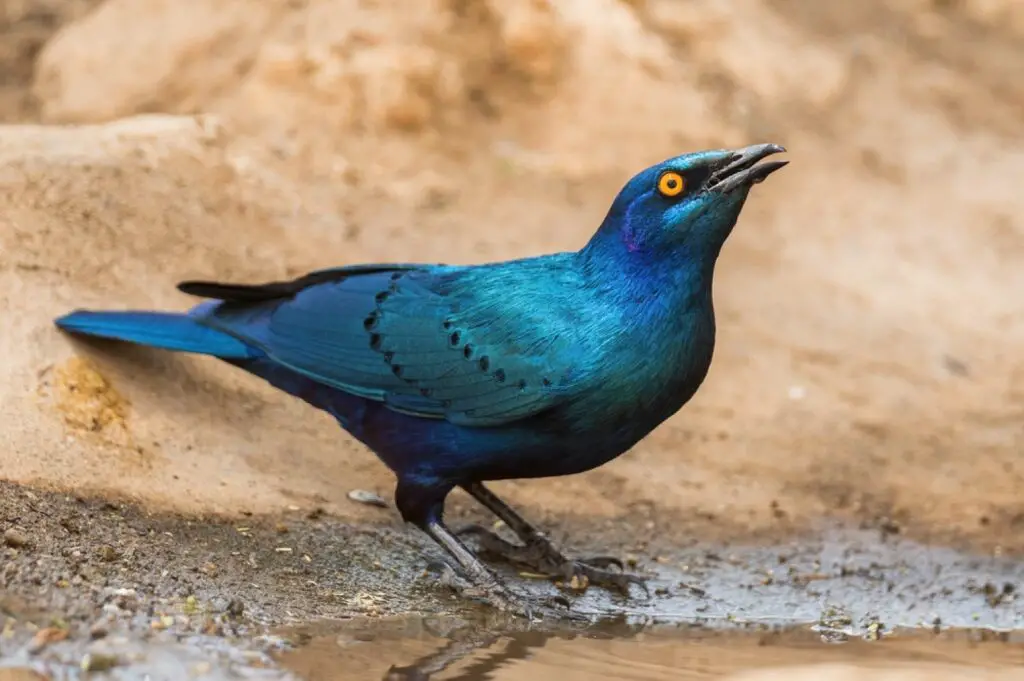
Scientific Name: Lamprotornis chalybaeus
Size: Approximately 7.5 to 8.7 inches (19 to 22 cm) in length.
Features: The Eastern Blue-tailed Glossy Starling, scientifically known as Lamprotornis chalybaeus, is a mesmerizing display of iridescent blue and green hues. Its upperparts shimmer with shades ranging from deep blue to emerald green, while its underparts showcase a rich blue coloration. This starling’s striking colors and glossy feathers set it apart as a jewel of the avian world.
Habitat: These stunning starlings are native to eastern and southern Africa, where they inhabit woodlands, savannas, and gardens. Their presence adds a touch of brilliance to the lush landscapes of their native habitats. Known for their gregarious nature, these starlings often gather in large flocks, creating a breathtaking spectacle.
8. Blue-winged Warbler (Vermivora cyanoptera):
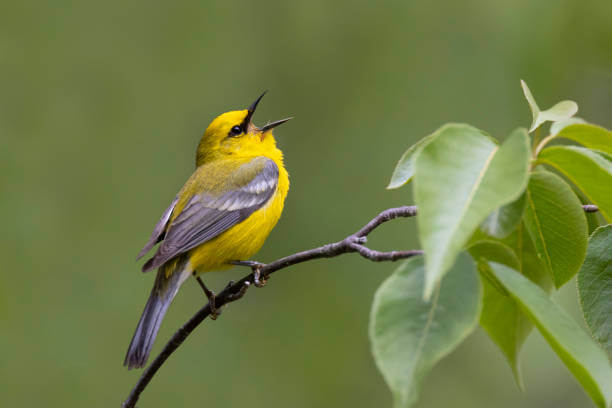
Scientific Name: Vermivora cyanoptera
Size: Approximately 4.3 to 4.7 inches (11 to 12 cm) in length, with a wingspan of around 6.3 inches (16 cm).
Features: The Blue-winged Warbler, scientifically referred to as Vermivora cyanoptera, is a small songbird that adorns itself with subtle yet captivating hues. Its upperparts are olive-green, while its wings are highlighted by vibrant blue patches. The contrast between the subdued body color and the bold blue wings creates a unique and appealing appearance.
Habitat: Blue-winged Warblers are found in the eastern United States and parts of Canada. They favor habitats such as shrubby areas, young forests, and edges of woodlands. Their distinct song, often described as a rising “bee-buzz,” is a familiar sound in their breeding territories during the spring and summer.
These two distinct bird species, the Eastern Blue-tailed Glossy Starling and the Blue-winged Warbler, showcase the remarkable spectrum of blue hues found in avian creatures. From the vivid brilliance of glossy feathers to the subtle elegance of wing patterns, these birds embody the artistry of nature’s palette.
9. Varied Bunting (Passerina versicolor):
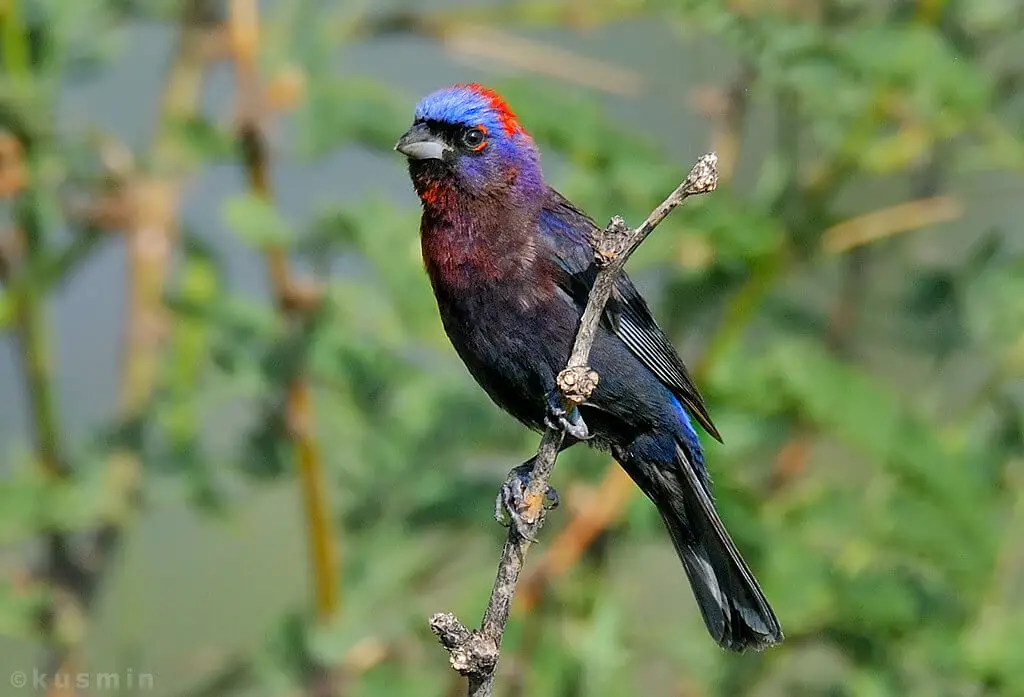
Scientific Name: Passerina versicolor
Size: Approximately 4.3 to 5.1 inches (11 to 13 cm) in length, with a wingspan of about 7.1 to 8.7 inches (18 to 22 cm).
Features: The Varied Bunting, scientifically known as Passerina versicolor, is a true embodiment of color diversity. Males flaunt a vibrant mix of blue, purple, and red on their head, back, and wings, while females exhibit a more subdued blend of olive and yellow. Their unique combination of hues is a visual testament to the wonders of avian pigmentation.
Habitat: Varied Buntings are native to arid and semi-arid habitats in southwestern North America and parts of Mexico. They inhabit desert shrublands, thorny thickets, and brushy areas. Their striking appearance and cheerful songs often make them stand out against the arid landscapes they call home.
10. Splendid Fairywren (Malurus splendens):
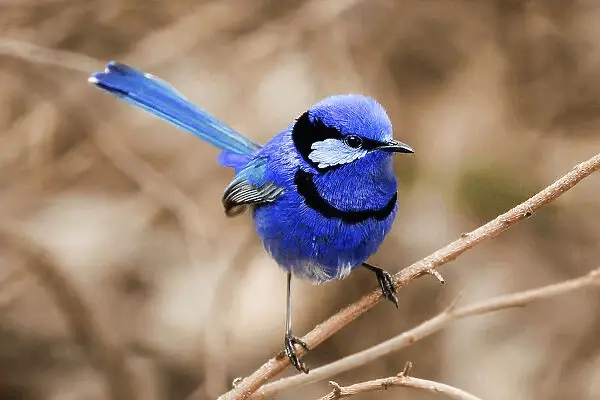
Scientific Name: Malurus splendens
Size: Approximately 3.9 to 4.7 inches (10 to 12 cm) in length.
Features: The Splendid Fairywren, scientifically referred to as Malurus splendens, is a living embodiment of enchantment. Males undergo a stunning transformation during the breeding season, displaying deep blue plumage on their crown, back, and tail. In contrast, non-breeding males and females exhibit brown and grayish hues. This fairywren’s vibrant transformation has earned it its name.
Habitat: Splendid Fairywrens are native to Australia, where they inhabit a range of habitats, including woodlands, shrublands, and gardens. Their presence adds a touch of magic to their surroundings, especially when the males don their striking blue colors. These fairywrens are known for their energetic behavior and frequent vocalizations.
The Varied Bunting and the Splendid Fairywren demonstrate the captivating allure of avian diversity. Whether gracing desert landscapes with their multicolored plumage or weaving an air of enchantment through Australian habitats, these birds remind us of the endless surprises that nature’s palette can offer.
11. Black-faced Grassquit (Tiaris bicolor):
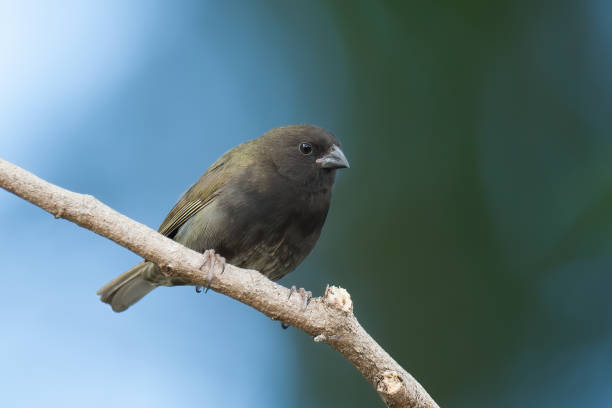
Scientific Name: Tiaris bicolor
Size: Approximately 4.3 to 4.7 inches (11 to 12 cm) in length.
Features: The Black-faced Grassquit, scientifically known as Tiaris bicolor, is a small songbird that showcases subtle yet captivating colors. Males exhibit a striking black face with a contrasting white belly and grayish-brown upperparts. Females, on the other hand, are more uniform in their appearance with muted brownish hues. Their unassuming yet attractive plumage sets them apart in their native habitats.
Habitat: Black-faced Grassquits are native to a range of habitats, including grasslands, savannas, and open woodlands across the Caribbean and parts of Central and South America. These birds are often found perched on grass stalks or low branches, where they feed on grass seeds and small insects.
12. Azure-rumped Tanager (Tangara cabanisi):
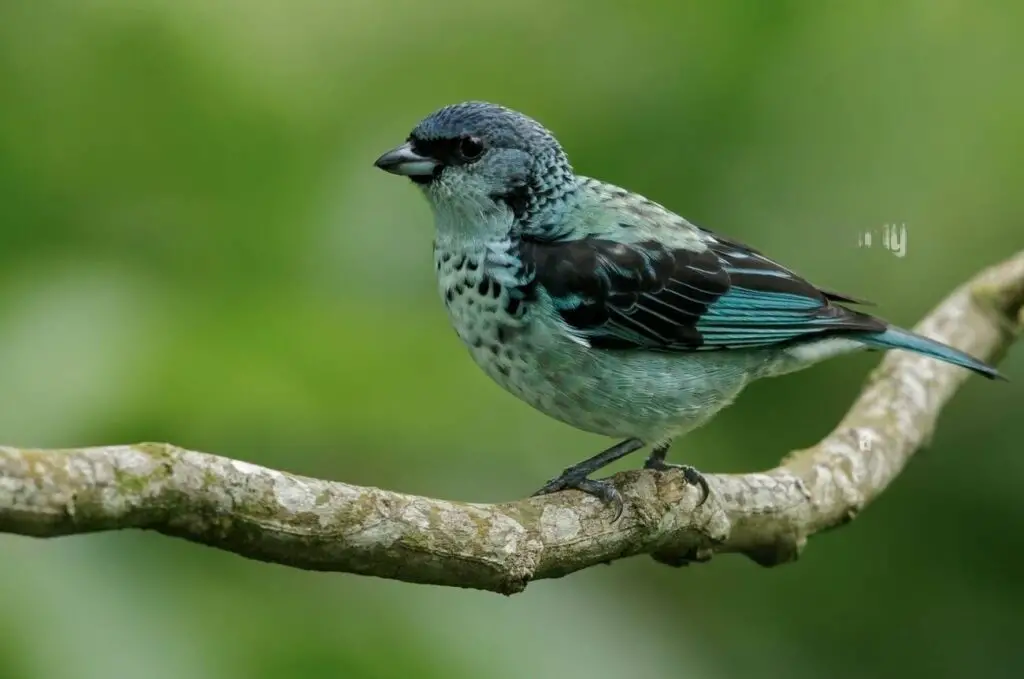
Scientific Name: Tangara cabanisi
Size: Approximately 4.7 to 5.1 inches (12 to 13 cm) in length.
Features: The Azure-rumped Tanager, scientifically referred to as Tangara cabanisi, is a visual masterpiece of iridescence. Its upperparts shimmer with shades of blue, green, and turquoise, while its underparts exhibit vibrant yellow hues. This tanager’s kaleidoscope of colors makes it a sought-after sight among birdwatchers.
Habitat: Azure-rumped Tanagers inhabit montane forests and cloud forests in Central America, particularly in regions like Costa Rica and Panama. Their dazzling plumage contrasts beautifully with the lush green foliage of their high-altitude habitats. These tanagers are often seen foraging for fruits, insects, and nectar among the treetops.
The Black-faced Grassquit and the Azure-rumped Tanager bring forth a captivating array of colors, showcasing the inherent beauty of avian life. Whether subtly adorned in black and white or adorned with a symphony of iridescent hues, these birds remind us of the artistry that nature effortlessly weaves into its creations.
13. Turquoise-browed Motmot (Eumomota superciliosa):
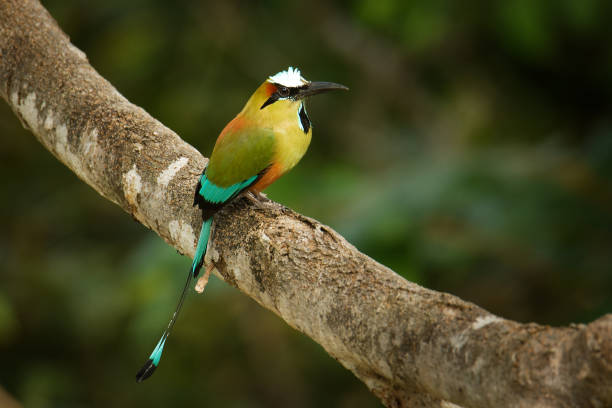
Scientific Name: Eumomota superciliosa
Size: Approximately 15 to 17 inches (38 to 43 cm) in length, with a distinctive long tail.
Features: The Turquoise-browed Motmot, scientifically known as Eumomota superciliosa, is a spectacular bird known for its vibrant plumage and unique tail feathers. Its head boasts a striking turquoise-blue crown, accompanied by a bold black eye mask. The tail is a sight to behold, adorned with blue-green feathers that resemble raquettes. This motmot’s appearance is both regal and mesmerizing.
Habitat: Turquoise-browed Motmots are native to Central America and can be found in a variety of habitats, including tropical forests, open woodlands, and gardens. Their presence often signals the lush beauty of these regions. They perch patiently, waiting for insects and small prey to approach before swooping down to capture their meal.
14. Blue-crowned Motmot (Momotus momota):
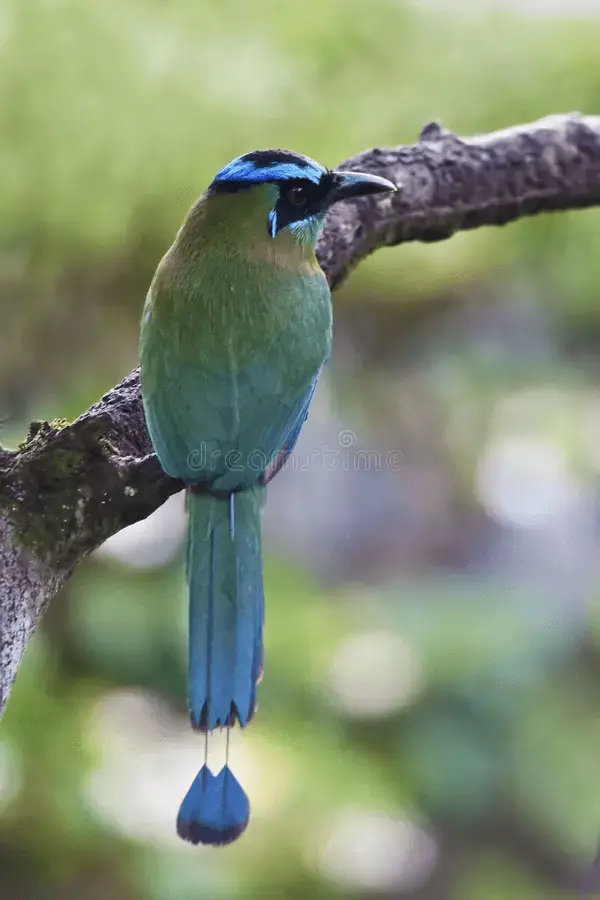
Scientific Name: Momotus momota
Size: Approximately 16.5 to 20 inches (42 to 51 cm) in length, with a long tail.
Features: The Blue-crowned Motmot, scientifically referred to as Momotus momota, is a captivating bird renowned for its remarkable appearance. Its head is adorned with a vibrant turquoise-blue crown, which contrasts elegantly with its earth-toned body. The tail feathers are long and racket-shaped, adding to its distinct charm.
Habitat: Blue-crowned Motmots inhabit a wide range of habitats in Central and South America, including rainforests, woodlands, and riparian areas. Their iconic call, often described as a melodic “woo-woo-woo,” is a signature sound of tropical landscapes. These motmots are skilled hunters, feeding on insects, small reptiles, and fruits.
The Turquoise-browed Motmot and the Blue-crowned Motmot exemplify the captivating allure of avian diversity. With their iridescent plumage, unique tail feathers, and vibrant colors, these birds remind us of the enchanting beauty that thrives in the heart of the natural world.
15. Black-throated Blue Warbler (Setophaga caerulescens):
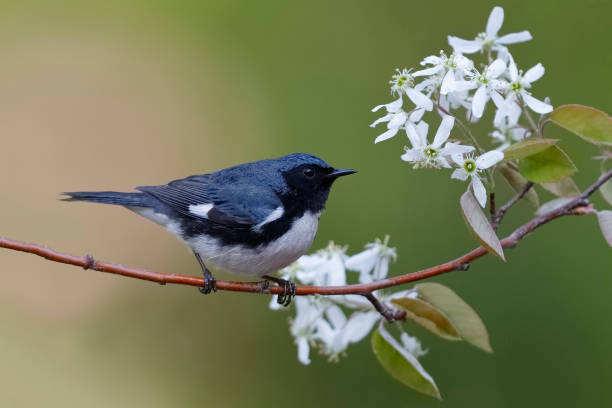
Scientific Name: Setophaga caerulescens
Size: Approximately 4.7 to 5.1 inches (12 to 13 cm) in length.
Features: The Black-throated Blue Warbler, scientifically known as Setophaga caerulescens, is a captivating songbird that boasts a striking color contrast. Males showcase deep blue upperparts and a vibrant black throat, creating a captivating pattern. Females exhibit more subdued colors, with bluish-gray upperparts and a pale throat.
Habitat: These warblers are commonly found in the eastern United States and parts of Canada during their breeding season. They inhabit a range of habitats, including deciduous forests and mixed woodlands. Their distinctive call, often described as a rising “zee-zee-zee,” can be heard in their leafy habitats.
16. Blue Grosbeak (Passerina caerulea):
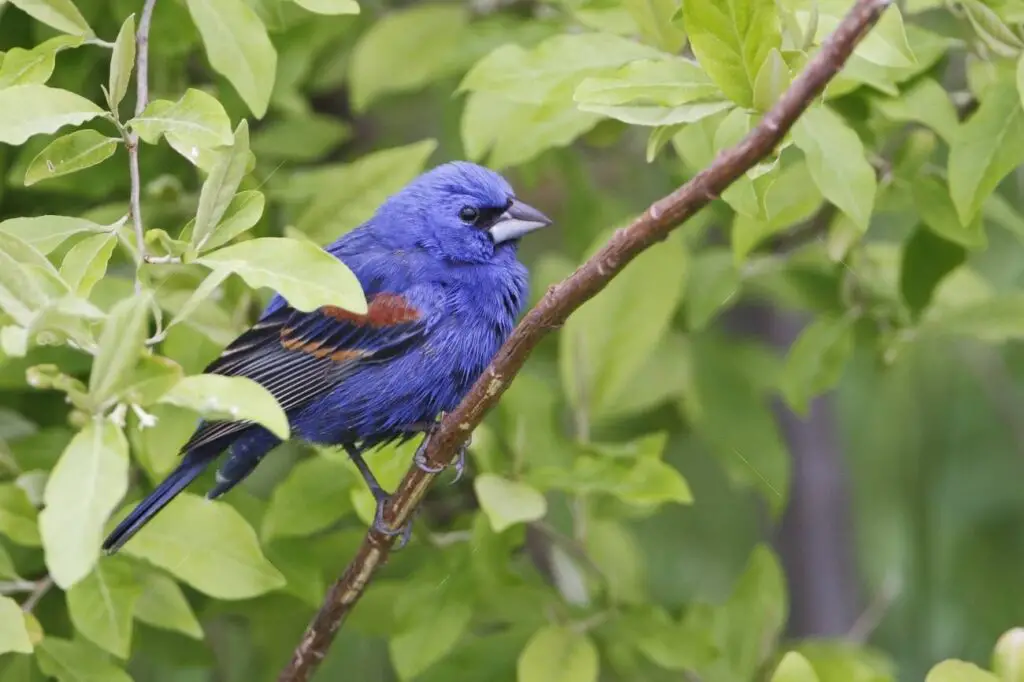
Scientific Name: Passerina caerulea
Size: Approximately 6.3 to 7.5 inches (16 to 19 cm) in length.
Features: The Blue Grosbeak, scientifically referred to as Passerina caerulea, is a stunning bird with a blend of rich blue and rusty hues. Males exhibit vibrant blue plumage on their head, back, and wings, while their breast showcases a warm chestnut color. Females are generally more subdued in appearance, with brownish-gray plumage.
Habitat: Blue Grosbeaks can be found in a variety of habitats, including grasslands, brushy areas, and open woodlands, across North and Central America. Their melodious song adds to their charm, often heard during their breeding season. These grosbeaks are adept at foraging for seeds and insects.
The Black-throated Blue Warbler and the Blue Grosbeak exemplify the captivating range of blue shades found in avian species. Whether gracing the woodlands of North America with their enchanting melodies or showcasing vibrant patterns, these birds remind us of the kaleidoscope of colors that nature has to offer.
17. European Roller (Coracias garrulus):
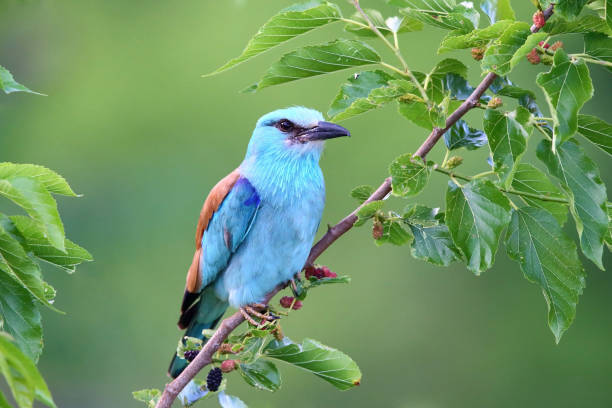
Scientific Name: Coracias garrulus
Size: Approximately 12.2 to 13.8 inches (31 to 35 cm) in length.
Features: The European Roller, scientifically known as Coracias garrulus, is a striking bird adorned with a mix of vibrant colors. Its head and back showcase a stunning turquoise-blue, while its chest is a warm orange-brown. The contrasting colors make this roller a visual spectacle.
Habitat: European Rollers are found across parts of Europe, Central Asia, and North Africa. They prefer open landscapes such as grasslands, farmlands, and savannas. Their aerial acrobatics and distinctive rolling flight add to their charm, making them a sought-after sight for bird enthusiasts.
18. Blue-naped Chlorophonia (Chlorophonia cyanea):
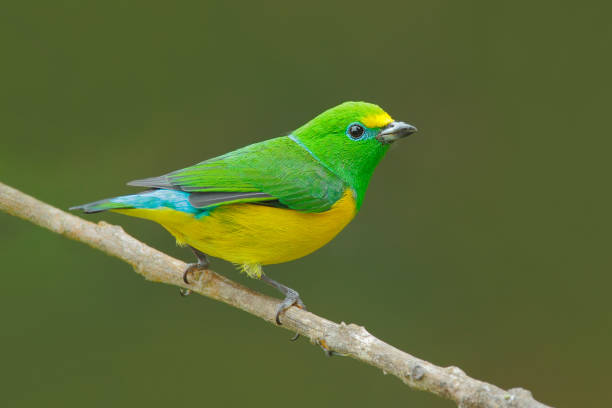
Scientific Name: Chlorophonia cyanea
Size: Approximately 4.3 to 5.1 inches (11 to 13 cm) in length.
Features: The Blue-naped Chlorophonia, scientifically referred to as Chlorophonia cyanea, is a small bird that flaunts an exquisite combination of blue and green hues. Its crown showcases a vibrant blue, transitioning to a rich green on its back and wings. The contrast between these colors makes it a remarkable sight.
Habitat: Blue-naped Chlorophonias inhabit cloud forests and montane habitats in Central and South America. They are often found in the canopy, where they feed on fruits, insects, and nectar. Their melodious calls add a musical touch to their high-altitude habitats.
The European Roller and the Blue-naped Chlorophonia bring a global perspective to the array of blue-colored avian species. From the open landscapes of Europe to the lush forests of Central and South America, these birds remind us of the kaleidoscope of colors that enrich our natural world.
Must Read:-
- Biggest Birds in the World
- Feeding the Kings of the Wild
- Exploring (10 Different Species Of Monkeys)
- Top 10 Most Dangerous Animals in the World
- [Top 10] Most Stunning Fish in the World
Conclusion
In the realm of avian diversity, bluebirds stand as living works of art, showcasing the elegance and vibrancy that nature can bestow. From the striking hues of the Turquoise-browed Motmot to the subtle beauty of the Black-faced Grassquit, each species tells a unique tale of adaptation and evolution. As these magnificent birds grace our skies and habitats, they serve as a reminder of the intricate beauty woven into the fabric of our world, inviting us to marvel at the wonders of the natural palette.

